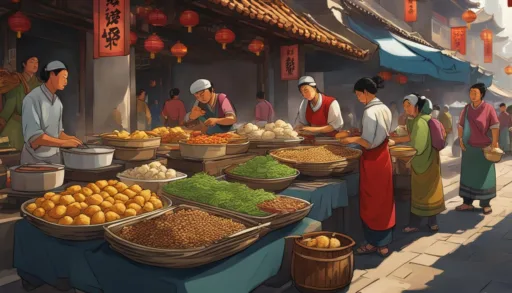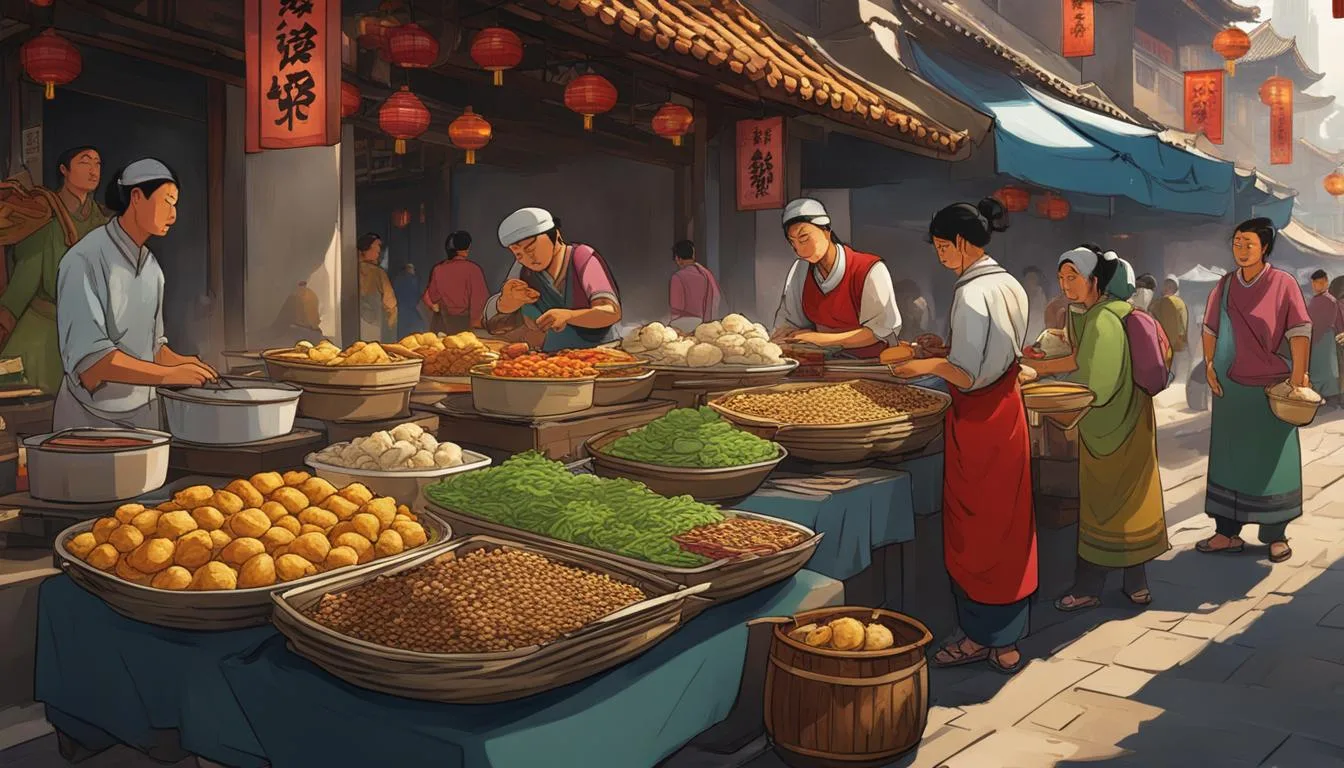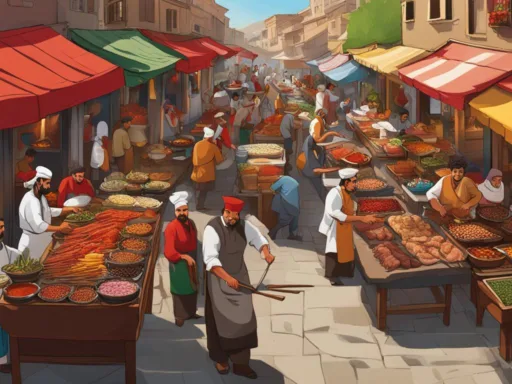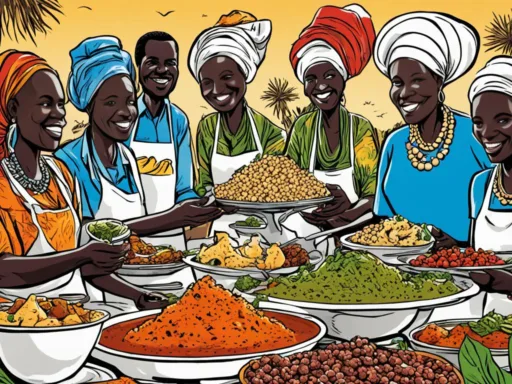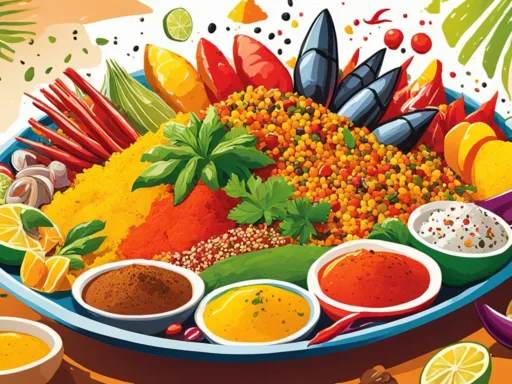Did you know that China is home to over 3,000 distinct types of traditional dishes? This staggering number only hints at the depth of the Chinese culinary heritage, a tapestry of tastes that has been woven into the country’s fabric for millennia. An authentic Chinese cuisine exploration transports you far beyond the popular dishes that have charmed international palates, delving into an ancient world of flavor where each province tells its own edible story. Whether you savor the spicy kick of a Sichuan stir-fry or the refined simplicity of a steamed Cantonese dumpling, authentic Chinese dishes embody a complex balance of color, aroma, and flavor.
Join us on a journey that traverses the vast geographical and cultural landscape of China, where traditional Chinese cooking practices create more than just meals—they craft experiences that linger long after the last bite. The relevance of Chinese food culture resonates in its ability to continually influence culinary trends across the globe. As we explore the resplendent array of regional cuisines, we invite you to immerse yourself in the rich tapestry that makes Chinese fare a perennial subject of culinary fascination.
Key Takeaways
- Discover the sheer variety of authentic Chinese dishes that number in the thousands.
- Experience the rich diversity of regional flavors that define Chinese culinary heritage.
- Understand how traditional Chinese cooking techniques contribute to the world-famous gastronomy.
- Appreciate the historical significance and cultural depth of Chinese food culture.
- Embrace the significance of each dish as a storyteller of China’s well-seasoned history.
The Historical Palette: Origins of Chinese Culinary Traditions
Delving into the rich tapestry of Chinese culinary traditions unlocks a history as ancient as the Great Wall itself. The cradle of Chinese cuisine experience lies in the heart of its vast history, spanning over countless dynasties each contributing their own nuances to the Chinese dishes and flavors. Exploring Chinese gastronomy is akin to traversing through time, witnessing the interweaving of culinary evolution and historical events.
The Evolution of Chinese Cuisine from Ancient Times
From the rustic cauldrons of ancient Chinese settlements to the imperial banquets of the Forbidden City, the evolution of Chinese cuisine is a tale of innovation and adaptation. Chinese kitchen artistry, which began shaping during the Shang Dynasty, has metamorphosed through the ages under the guiding influences of both philosophical thought and tangible needs of sustenance. Each dynasty brought forth its own culinary delights with Emperor’s demands further honing the craft of cookery in the pursuit of perfection.
It was during the time of the Silk Road that Chinese cuisine began absorbing external culinary influences, integrating new ingredients and techniques into its repertoire. This burgeoning trade route not only exchanged silk and spices but also gastronomic knowledge that would eventually lead to the tantalizing array of Chinese dishes known today.
Regional Differences Influencing Flavor Profiles
The vastness of China’s geography mirrors its culinary diversity. Each Chinese region basks in its own palette of flavors, shaped by climate, resources, and historical interact. The Northern plains with their biting cold cherish hearty, wheat-based dishes while the coastal East with their bounty of the sea prize delicate flavors and freshness.
Sichuan Province: Home to the infamous Sichuan pepper, it’s a land where fiery chilis meet the distinctive numbing spice in a dance of heat and flavor that is both bold and complex.
Guangdong (Cantonese) Cuisine: Here lies the art of subtlety, a celebration of the ingredients’ intrinsic tastes with minimal alteration, crafting dishes that please the palate with gentle, refreshing flavors.
The intricacies of Chinese cuisine are endless, and the journey to explore its history and flavors is as mesmerizing as it is delectable. Through the annals of time, Chinese gastronomy has emerged not as a static monument, but a living, breathing cultural legacy that invites curiosity and indulgence.
Unveiling the Flavors: A Taste of Regional Chinese Cuisines
The quest for Chinese cuisine exploration leads us on an aromatic adventure across the vast nation, a journey accented by the remarkable diversity inherent to Traditional Chinese cooking. As we traverse the Chinese culinary landscape, we encounter not merely a singular cuisine but a tapestry of regional dialects in food, with each locale narrating its distinct gastronomic lore.
This exploration introduces the palate to Sichuan’s piquant offerings, famed for their electrifying heat, versus the understated elegance of Jiangsu’s fare. Gastronomic sojourners revel in the robustness of northern flavors and the dynamic, zesty zest that characterizes Southeastern China’s tables.
Below is a representative table capturing the essence of each unique regional flavor profile:
| Region | Flavor Characteristics | Signature Dishes |
|---|---|---|
| Sichuan | Hot and numbing with bold use of garlic and chili peppers | Kung Pao Chicken, Ma Po Tofu |
| Jiangsu/Zhejiang | Sweet and mild, often highlighting the freshness of ingredients | Sweet and Sour Mandarin Fish, West Lake Fish in Vinegar Gravy |
| Northern China | Hearty and rich with wheat-based staples like noodles and buns | Peking Duck, Zhajiangmian |
| Southeastern China | Spicy and sour with a prevalence of pickling and fermentation | Preserved Duck Eggs, Yibin Burning Noodles |
Echoes of ancient dynasties and the migratory murmur of the Silk Road are palpable in every bite, every dish. While the table outlines staples and their inherent flavors, there’s an unspoken invitation to dive deeper, to savor the complexity and history folded into each dish—a hallmark of genuine Chinese cuisine exploration.
The myriad of flavors beckons food enthusiasts to experience a culinary odyssey that promises to satiate and educate, urging a deeper appreciation for a culture where food is not merely sustenance but a vessel of history, a storyteller on a plate.
Chinese Cuisine Exploration: Sichuan’s Fiery Reputation
Embarking on a Sichuan cuisine experience takes one on an exhilarating journey through a symphony of flavors that ignite the senses. Renowned for its bold use of spices, this culinary style embodies the heritage of traditional Chinese cooking techniques. It’s not solely about the heat; it’s about crafting an impeccable flavor profile that represents the historical thrust of authentic Chinese dishes in every bite.
Signature Dishes of Sichuanese Cuisine
At the epicenter of Sichuan gastronomy are iconic dishes that articulate the region’s unyielding passion for depth and complexity. The infamous Kung Pao Chicken, with its piquant combination of sweet, sour, and spicy notes, offers a multidimensional taste that resonates with authenticity. Similarly, Ma Po Tofu, cloaked in an aromatic sauce, strikes an intricate balance between the numbing sensation of Sichuan peppercorns and the richness of bean curd—a testament to the artfulness of the cuisine.
The Art of Balance in Sichuan Cooking
What distinguishes Sichuan fare from other cuisines is the masterful equilibrium of flavors. A Sichuan chef is akin to a maestro, orchestrating a harmony of tastes that marries the fierceness of chilies with the subtler tones of the region’s diverse ingredient palate. The true artistry is found in sculpting dishes where no single element overwhelms another, but rather complements to create a coherent and exquisite gustatory experience.
Chili and Sichuan Peppercorn: The Icons of Spice
Chili and Sichuan peppercorn stand as pillars of Sichuan flavor. Where the chili brings a vivid, fiery zest, the Sichuan peppercorn contributes a unique, tingling aroma that defines the region’s repertoire. These spices are not blunt instruments of heat but sophisticated tools used with precision to achieve a unique culinary identity. This spicy duo underpins the Sichuan cuisine experience, enchanting those who seek the thrill of authentic Chinese dishes.
Cantonese Cuisine: Delicacy and Finesse in Every Dish
Steeped in tradition and finesse, the Cantonese cuisine exploration is an unforgettable journey into the heart of Chinese food culture. Known for its emphasis on preserving the natural flavors and textures of the ingredients, Cantonese chefs skillfully present an array of authentic Chinese dishes that speak to both the palate and the soul. In Guangdong, where family and food are intertwined, the marriage of culinary artistry with communal dining rituals forms the cornerstone of this exquisite gastronomic experience.
Dim Sum: The Heart of Cantonese Family Dining
Dim sum, a meal composed of small, delectable bites, encapsulates the essence of Cantonese communal dining. Often served in bamboo steamers, these bite-sized treasures range from savory dumplings to sweet pastries, each one a testament to the region’s culinary prowess. Gatherings around the dim sum table are not just about eating; they are social events where stories are shared, and bonds are strengthened—a true reflection of the spirit of Cantonese family values.

The variety offered by dim sum is as diverse as the diners themselves, each item meticulously prepared to offer nuanced flavors and exquisite mouthfeel. The craft of making dim sum is a revered skill, often passed down through generations, keeping the culinary techniques and family recipes alive and vibrant in the modern era.
Freshness and Variety in Cantonese Ingredients
Central to Cantonese cuisine is the principle of showcasing the freshest ingredients, each selected for their peak quality and flavor. The coastal proximity of Guangdong province provides an abundant supply of seafood, while lush valleys and hills contribute a variety of produce, herbs, and meats—each ingredient playing a pivotal role in the composition of authentic dishes.
| Ingredient | Use in Cantonese Cuisine | Preparation Method |
|---|---|---|
| Seafood | Main protein in many dishes | Often steamed to retain natural taste |
| Vegetables | Complement and balance meat flavors | Stir-fried with light sauces to enhance freshness |
| Meat (Pork, Beef, Chicken) | Featured in dim sum and entrees | Marinated and cooked to tender perfection |
Cantonese chefs masterfully apply techniques such as steaming and stir-frying, which not only uphold but elevate the natural integrity of the ingredients. The result is a cuisine characterized by gentle flavors, elegant presentation, and a harmonious blend of textures that truly respects and celebrates the produce’s intrinsic qualities.
In conclusion, the pursuit of the Cantonese cuisine exploration is more than a mere tasting endeavor—it’s an immersive experience into a culinary tradition where every dish is served with a touch of grace and a deep respect for the harmony of flavor and nourishment.
Discovering the Delights of Peking Duck and Other Beijing Specialties
Beijing, China’s capital, is a melting pot of flavors and aromas that contribute to its significant position in the culinary world. At the forefront of Beijing’s dining scene is Peking Duck, an exquisitely prepared dish that reflects the sophisticated culinary craftsmanship of Chinese cuisine exploration. It’s a point of pride in Beijing culinary heritage, savored by locals and international food connoisseurs alike. Alongside this classic, Beijing’s street food offerings present an eclectic taste of the city, encapsulating both the traditional essence and the innovative spirit of Northern Chinese fare.
The Intricate Preparation of Peking Duck
The creation of Peking Duck is an intricate process that has been perfected over centuries, demanding precision and patience. The result is a dish with crispy, golden skin and tender, flavorful meat. The traditional method involves inflating the duck to separate the skin from the fat, then glazing it with a layer of maltose syrup before roasting it in a closed oven or hung oven. This meticulous roasting process is the secret behind the distinctive texture and flavor that has made Peking Duck a global icon of Chinese gastronomy.
Beijing Street Food Culture
Strolling through the bustling hutongs of Beijing, one is enveloped by the rich tapestry of the city’s street food culture. These busy alleys offer a symphony of sizzling woks, the aroma of spices, and the chatter of satisfied customers. A tableau of traditional snacks like Jianbing (savory crepes), sugar-coated hawthorn berries, and savory Donkey Burgers, Beijing’s street food scene invites an informal and authentic experience of local flavors.
| Peking Duck | Beijing Street Snacks |
|---|---|
| Roasted to crispy perfection | Variety of flavors and textures |
| Served with pancakes and sweet bean sauce | Includes both sweet and savory choices |
| Long history as a royal dish | Deep-rooted in everyday culture and lifestyle |
| Eaten in formal settings and special occasions | Enjoyed as everyday meals and snacks |
In the journey of Chinese cuisine exploration, one would be remiss to overlook the cultural significance and culinary delight of Peking Duck. It’s not merely a dish but a representation of Beijing’s rich, enduring culinary traditions. As we delve deeper into the hearty and diverse offerings of street vendors, we uncover the unpretentious charm of Beijing’s gastronomy that continues to write its legacy in the annals of world cuisine.
Authentic Chinese Dishes: Beyond Western Adaptations
When it comes to authentic Chinese dishes, there’s a world of difference between the western adaptations commonly found abroad and the rich, diversified flavors rooted in Chinese food culture. These traditional meals present an opportunity for exploring Chinese gastronomy at a depth that cannot be replicated by their westernized versions. Contributing to their authenticity is the intricate balancing act of flavors and textures, intertwined with centuries of culinary history unique to the diverse regions across China.

One of the hallmarks of genuine Chinese cuisine is the use of fresh, regionally sourced ingredients which are prepared using traditional methods passed down over generations. This not only maintains the culinary integrity of classic recipes but also pays homage to the cultural significance of each dish. By incorporating elements such as the philosophical principle of Yin and Yang to achieve a harmonious balance in taste and nourishment, these dishes go beyond mere sustenance to represent a way of life.
The complexity and depth of flavors found in authentic Chinese dishes are largely due to a variety of traditional cooking techniques which include:
- Stir-frying at high heat to intensify flavor while preserving texture
- Steaming to maintain the natural essence of ingredients
- Braising with a combination of soy sauce, sugar, and spices to achieve a richly flavored, tender result
These techniques all contribute to a culinary authenticity that is both a craft and an art form, capturing the true spirit and tradition inherent in Chinese meals. To fully appreciate the nuance and artistry of Chinese cuisine, one must delve into the authentic creations—untouched by westernizing processes, where the legacy of China’s diverse gastronomy continues to thrive and inspire food aficionados around the globe.
Glossary of Chinese Culinary Heritage: A Guide to Traditional Cooking Techniques
The vast expanse of Traditional Chinese cooking encompasses an intricate network of methods that have been honed over centuries. Delving into these techniques unveils the foundation upon which Chinese culinary heritage proudly stands. For both the culinary novice and the experienced gastronome, understanding these practices is imperative to crafting authentic Chinese dishes. Below is a concise guide to some of the most quintessential cooking techniques found in Chinese cuisine:
- Stir-frying (炒, chǎo): A high-heat, fast cooking technique that keeps ingredients in constant motion, ensuring they are evenly cooked while retaining their texture and nutrients.
- Steaming (蒸, zhēng): A gentle heat method that retains the natural flavors, colors, and nutrients of ingredients, frequently used for delicate foods like fish and dim sum.
- Roasting (烤, kǎo): Involving dry heat cooking, this technique creates a seared, flavorful crust over succulent meats, such as the globally adored Peking Duck.
- Braising (煨, wēi / 红烧, hóngshāo): Ingredients are first sautéed or seared at high temperatures, then finished in a covered pot with liquid, leading to tender and rich flavors.
These primary techniques have been passed down and refined through generations, integral not only to the identity of individual dishes but also to the overarching ethos of Chinese food preparation. To further illustrate the building blocks of Chinese culinary heritage, let’s consider some iconic examples:
| Cooking Technique | Dish Examples |
|---|---|
| Stir-frying | Kung Pao Chicken, Beef and Broccoli |
| Steaming | Har Gow (Shrimp Dumplings), Steamed Fish with Ginger and Scallions |
| Roasting | Peking Duck, Char Siu (BBQ Pork) |
| Braising | Red Braised Pork Belly, Braised Eggplant |
The essence of Chinese culinary practices is not just in their flavors or outcomes, but in the philosophy that underpins them—harmony, balance, and respect for the produce. By engaging with these time-honored techniques, food lovers can immerse themselves in a culture that treasures each meal as a work of art and a communal celebration.
Farm to Table: Fresh Ingredients in Chinese Cuisine
The essence of traditional Chinese cooking is encapsulated in the age-old tradition of farm-to-table dining. This enduring approach celebrates the integrity of fresh ingredients, which are the cornerstone of dishes renowned for their vibrant flavor and nutritive value. In this section, we explore the vital relationship between fresh produce and Chinese culinary mastery, alongside the historical influence of the Silk Road on food diversity in China.

Seasonal Eating and its Role in Chinese Cooking
In China, the rhythm of the seasons profoundly influences eating habits and culinary choices. Rather than a recent trend, seasonal eating is deeply integrated into Chinese culture, where each season provides a unique palette of ingredients, aligning food preparation with the cycle of nature. The result is a cuisine that is not only fresh but also attuned to what is naturally abundant, ensuring dishes of optimum freshness and flavor.
The Silk Road’s Influence on Ingredient Diversity
The historic Silk Road was not just a conduit for goods, but also ideas and culinary exchanges. Its influence permanently expanded the Chinese pantry with a variety of new ingredients and spices. This cross-cultural intermingling enriched traditional Chinese cooking, introducing an exciting array of flavors that chefs and home cooks continue to incorporate into authentic Chinese dishes.
| Season | Fresh Ingredients | Silk Road Contributions |
|---|---|---|
| Spring | Bamboo Shoots, Snow Peas | Central Asian Melons, Persimmons |
| Summer | Lychee, Dragon Fruit | Middle Eastern Dates, Figs |
| Autumn | Mushrooms, Chinese Yam | Indian Spices, Rice Varietals |
| Winter | Radishes, Preserved Vegetables | Medicinal Herbs, Barley |
Embracing the farm-to-table ethos, traditional Chinese cooking incorporates fresh ingredients for their inherent vibrancy, while the Silk Road influence continues to be felt in the diverse flavors enriching dishes across the nation. This combination of tradition and historic international influence makes Chinese cuisine a living legacy that is ever-evolving, drawing from its roots yet constantly innovating.
Best Chinese Restaurants: A Global Tour of Excellence
For those seeking the ultimate Chinese cuisine exploration, the journey to find the best Chinese restaurants spans continents, cultures, and culinary philosophies. These esteemed eateries are not just places to dine; they are sanctuaries where the intricate layers of Chinese food culture unfold in each bite. Join us in celebrating these bastions of culinary brilliance.
Leading the pack are Michelin-starred titans in Hong Kong, where innovation meets tradition. Each establishment offers a different interpretation of classic dishes, infused with a spirit of modernity that caters to the evolving palates of global gourmands.
Discovering a hidden gem in a bustling Chinatown provides a different kind of delight: the authenticity of flavors, the homage to generational recipes, and the sheer joy of sharing a meal with both new friends and old.
From New York to San Francisco, London to Sydney, Chinese culinary excellence is an omnipresent treasure waiting to be discovered. Below, we highlight some key features these world-class restaurants showcase:
- Commitment to authentic Chinese recipes
- Modern interpretations of traditional dishes
- Elegant ambiances that tell a story
- Fusion creations that respect Chinese culinary roots
A dining experience at one of these top-tier venues goes beyond taste—it’s an immersive encounter with history, art, and the craft of gastronomy, eagerly awaiting those willing to partake in its richness.
Exploring Chinese Gastronomy: From Noodles to Rituals
The intricate web of Chinese dishes and flavors extends beyond the surface of stir-fries and dumplings, into an expanse where each strand tells a story. Among these, noodles emerge as a tale of universality and tradition, weaving into the fabric of countless cultures. While understanding the depth of the Chinese cuisine experience, it is paramount to appreciate the culinary rituals that transcend the act of eating and touch upon the essence of communal living.

The Universality of Noodles Across Cultures
In exploring Chinese gastronomy, one cannot ignore the global trail of noodles. From the supple strands of lo mein in Xi’an to the robust forms of pasta in Italy, noodles serve as a testament to culinary exchange along the ancient Silk Road. Diverse in preparation and symbolism, these dishes offer a glimpse into the shared narratives that have sculpted global cuisines.
Cultural Significance of Mealtime in Chinese Society
Mealtime in Chinese culture is elevated to a ritual, reinforcing the threads of community and harmony. Gathered around a circular table, individuals partake in a dance of platters, an act that solidifies bonds and embodies the collective spirit. The importance placed on these dining rituals encapsulates a respect for togetherness and continuity that is core to the Chinese cuisine experience.
| Cultural Element | Role in Chinese Gastronomy | Global Presence |
|---|---|---|
| Noodles | Staple food, diverse in form and preparation | Integral to many cultures, variations seen worldwide |
| Mealtime Rituals | Reinforces social harmony and family bonds | Similar concepts observed in communal dining etiquettes globally |
| Communal Dining | Facilitates sharing and communal decision-making | Shared dining practices promote unity in various cultures |
The artistry of exploring Chinese gastronomy lies not only in the flavors but in the experiences that shape each meal. From the omnipresent noodles to the ceremonial nature of dining, Chinese cuisine extends an invitation to participate in rituals rich with history and significance, prompting an exploration that satisfies both palate and soul.
Chinese Cuisine Experience: Dining Etiquette and the Community Feast
The allure of Chinese cuisine lies not just in the delicate flavors and time-honored recipes, but in the intricate dance of dining etiquette that accompanies every meal. To partake in a Chinese banquet is to immerse oneself in an experience steeped in tradition and communal spirit, a fundamental extension of the country’s rich cultural tapestry. As one sits at the round table, the embodiment of equality and unity, each dish served is a silent nod to the ancient principles that have shaped the dynamics of family and society in China.
Communal Dining: Understanding the Importance of Sharing
In traditional Chinese cooking, there is an emphasis on sharing that goes beyond mere culinary practice—it’s about cementing bonds and cherishing relationships. The act of dining together is an intimate affair, where the finest slices of Peking Duck or the warmest bowl of congee are not just foods to satisfy hunger. They are symbols of love, care, and mutual respect.
The etiquette that shapes this Chinese culinary heritage is both an art and a science. It governs not only which dish is served first or how one should hold the chopsticks but also reflects the hierarchical subtleties often present in Chinese gatherings. To sit elder relatives at the seat of honor and to serve them the first bite is more than manners; it’s an age-old tribute to their wisdom and a way to express filial piety.
Indeed, the community feast is a cornerstone of the Chinese cuisine experience, a joyous celebration where food and culture intertwine to create memories that last a lifetime. As the Lazy Susan turns, ferrying myriad flavors across the table, each turn is a reminder that in sharing we receive, and in the nuances of this delightful tradition, we find the beating heart of Chinese culinary heritage.
China’s Contributions to World Cuisine: A Culinary Exchange
The narrative of Chinese Cuisine Exploration is woven into the very fabric of international gastronomy. Through a storied past of trade on the Silk Road, Chinese culinary methods and ingredients have traveled far and wide, engraining themselves into the food customs of nations across the globe. This exchange is more than a story of spices and recipes—it’s a tale of cultural interactions that have enriched global culinary practices.
Chinese dishes and flavors have crossed borders and have become cornerstones in the mosaic of world food culture. The versatility of Chinese cooking techniques and the depth of flavor profiles have had a sweeping global culinary influence, greatly enhancing the diversity of various international cuisines. Let us delve deeper into specific instances where Chinese gastronomy has significantly left its mark.
- The infusion of Chinese spices into Southeast Asian cooking, bringing a blend of sweet, sour, and heat to local dishes.
- The concept of dim sum inspiring similar traditions of small plate dining in different parts of the world.
- Noodle dishes that have evolved differently depending on the region, from ramen in Japan to pho in Vietnam.
- The wok, a quintessential tool in Chinese kitchens, now a common implement in kitchens worldwide, due to its efficiency and versatility.
In every corner of the world, the spirit of Chinese cuisine is palpable, whether it is the art of stir-frying or the humble soy sauce – its influence is undeniable, enriching and diversifying the global culinary landscape one dish at a time.
In conclusion, as we appreciate the breadth of Chinese Cuisine Exploration, we must acknowledge the undeniable exchange that has occurred throughout history. The culinary contributions from China have not only shaped the eating habits and cooking styles of various cultures, but also underscored the importance of embracing and understanding our interconnected global food heritage.
Conclusion
As we wind down our immersive journey into Chinese cuisine exploration, it’s evident that the vast landscape of this ancient gastronomy is as intricate and captivating as the country from which it hails. Traditional Chinese cooking is not just about the sumptuous flavors and inviting aromas; it represents a narrative that has been shaped over millennia, woven into the very fabric of Chinese culture and extending beyond its borders. The artistry found in authentic Chinese dishes—from the sizzle of a fiery Sichuan wok to the subtle complexity of a steamed Cantonese delicacy—speaks volumes about the ingenuity and sophistication of Chinese culinary creators.
Embracing the Diversity and Traditions of Chinese Food Culture
In a tapestry threaded with diverse ingredients and cultural depth, embracing the traditions of Chinese food culture is akin to embarking on an endless culinary odyssey. A true appreciation for this rich and diverse gastronomy emerges when one considers not only the iconic dishes but the underlying philosophy that values harmony, balance, and the communal aspect of dining. Moreover, each bite is an homage to a cuisine that has transcended time and place, positioning itself as an enduring and influential force in the global culinary spectrum.
Chinese Dishes and Flavors: Leaving a Lasting Global Impression
Finally, the global impression that Chinese dishes and flavors have imprinted on the world is undeniable. The distinctive essence of Chinese cuisine exploration has captivated taste buds far and wide, leaving a lasting legacy that continues to inspire and evolve. Authentic Chinese dishes have not only enriched the world’s culinary heritage but have also served as a bridge between cultures, showcasing how food can truly be a universal language. As the final course in our exploration concludes, we are left with a renewed reverence for traditional Chinese cooking and its capacity to unite and delight us all.
FAQ
What is Chinese Cuisine Exploration?
Chinese Cuisine Exploration is the immersive experience of discovering and experiencing the vast array of dishes that constitute China’s rich culinary tradition. It involves delving into the flavors, styles, and gastronomic history that make Chinese food culture one of the most diverse and complex in the world.
Can you describe some authentic Chinese dishes?
Authentic Chinese dishes such as Peking Duck, known for its crispy skin and tender meat, Dim Sum, a variety of bite-sized treats, Kung Pao Chicken and Ma Po Tofu with their fiery Sichuan flavors, and the balanced fish-flavored eggplant are all iconic examples. Each of these dishes carries a strong regional identity and reflects the depths of traditional Chinese cooking.
What makes regional Chinese cuisines different from each other?
Regional Chinese cuisines differ due to geographical, historical, and cultural influences. For example, Sichuan cuisine is renowned for its bold, spicy flavors with liberal use of Sichuan peppercorns and chilis, while Cantonese cuisine emphasizes fresh ingredients and delicate cooking techniques like steaming and stir-frying. These differences result in a wide range of flavor profiles and specialized dishes unique to each region.
What are some traditional Chinese cooking techniques?
Traditional Chinese cooking techniques include stir-frying, steaming, roasting, braising, and more. Each technique serves a specific purpose, from preserving the freshness and crispness of vegetables through quick stir-frying to enhancing the depth and richness of flavors through slow braising. Understanding these techniques is crucial to appreciating the complexity of authentic Chinese dishes.
How do fresh ingredients play a role in traditional Chinese cooking?
Freshness is at the core of traditional Chinese cooking, with a farm-to-table approach that emphasizes the use of seasonal, local ingredients to ensure the best flavors and nutritional benefits. The Chinese philosophy of seasonal eating reflects the harmonious balance between food and nature, making fresh ingredients a foundation of their culinary practices.
What sets the best Chinese restaurants apart?
The best Chinese restaurants stand apart for their dedication to the traditions and innovation of Chinese gastronomy. They provide an avenue for diners to savor authentic Chinese dishes and flavors, often highlighting specialized regional cuisines and culinary skills, and offer a dining experience that encompasses the culture and heritage of Chinese food culture.
What is the cultural significance of mealtime in Chinese society?
Mealtime in Chinese society is critical not just for the enjoyment of food but also for the social interaction and bonding it fosters. Meals are often shared family-style, reinforcing community bonds and social harmony. The cultural significance of dining together in this way resonates with the values of respect and togetherness in Chinese culture.
How do dining etiquette and communal feasting contribute to the Chinese cuisine experience?
Dining etiquette and communal feasting are central to the authentic Chinese cuisine experience. They involve practices like using chopsticks correctly, the round table’s significance for sharing meals, and ensuring that hospitality and respect are shown to guests. This cultural approach enhances the dining experience and provides insight into the values and traditions of Chinese society.
In what ways has Chinese cuisine contributed to world cuisine?
Chinese cuisine has had a significant impact on world cuisine through its long history of culinary exchange and adaptation. Ingredients and techniques from China, influenced by the historic Silk Road, have melded with other cultures, contributing to the global culinary landscape. Dishes like pasta and stir-fries have roots in Chinese cuisine and are now enjoyed worldwide, showcasing China’s global culinary influence.
Where can one find a true taste of Chinese culinary heritage?
A true taste of Chinese culinary heritage can be found in various places, from bustling street markets in Beijing offering local specialties to high-end Chinese restaurants worldwide. Such establishments often go to great lengths to use traditional cooking techniques, fresh ingredients, and regional recipes to provide an authentic and high-quality Chinese culinary experience.
